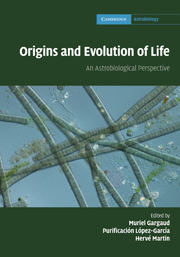Book contents
- Frontmatter
- Contents
- List of contributors
- Foreword
- Preface
- Part I What is life?
- Part II Astronomical and geophysical context of the emergence of life
- 6 Organic molecules in the interstellar medium
- 7 Cosmochemical evolution and the origin of life: insights from meteorites
- 8 Astronomical constraints on the emergence of life
- 9 Formation of habitable planets
- 10 The concept of the galactic habitable zone
- 11 The young Sun and its influence on planetary atmospheres
- 12 Climates of the Earth
- Part III The role of water in the emergence of life
- Part IV From non-living systems to life
- Part V Mechanisms for life evolution
- Part VI Life in extreme conditions
- Part VII Traces of life and biosignatures
- Part VIII Life elsewhere?
- Index
12 - Climates of the Earth
from Part II - Astronomical and geophysical context of the emergence of life
Published online by Cambridge University Press: 04 February 2011
- Frontmatter
- Contents
- List of contributors
- Foreword
- Preface
- Part I What is life?
- Part II Astronomical and geophysical context of the emergence of life
- 6 Organic molecules in the interstellar medium
- 7 Cosmochemical evolution and the origin of life: insights from meteorites
- 8 Astronomical constraints on the emergence of life
- 9 Formation of habitable planets
- 10 The concept of the galactic habitable zone
- 11 The young Sun and its influence on planetary atmospheres
- 12 Climates of the Earth
- Part III The role of water in the emergence of life
- Part IV From non-living systems to life
- Part V Mechanisms for life evolution
- Part VI Life in extreme conditions
- Part VII Traces of life and biosignatures
- Part VIII Life elsewhere?
- Index
Summary
Introduction
Since the beginning of this century, astronomers have discovered hundreds of exoplanets, almost all of them being giant planets. However, we expect the possibility of detecting relatively smaller exoplanets similar in size to our Earth soon. Among the thousands of exoplanets that will be discovered by the end of this century, some may host life. Obviously the possibility of finding life on another planet is not only a function of the number of discovered planets, but also of the stability of life on those planets: if life is only a glimpse, the search for life will be much harder! We have under our feet a marvellous example demonstrating that one kind of life may be hosted on a planet (Earth) for billions of years. This relative stability of life on Earth seems to be strongly correlated with the stable environmental conditions that have prevailed on the surface of our planet for several billion years (1 Ga = 109 years). This is the reason why this chapter is devoted to deciphering and understanding the ‘stable’ climate conditions on Earth since 3.8 Ga. Observation of our neighbouring planets in the Solar System teaches us that the conditions for the development of life (habitability) and sustainability at the surface of a planet are not widespread – at least in the Solar System. Nowadays, Mars is a very cold desert experiencing dust storms, whereas Venus is a burning hell whose surface is totally hidden by a thick greenhouse-gas atmosphere.
- Type
- Chapter
- Information
- Origins and Evolution of LifeAn Astrobiological Perspective, pp. 183 - 202Publisher: Cambridge University PressPrint publication year: 2011
- 2
- Cited by



